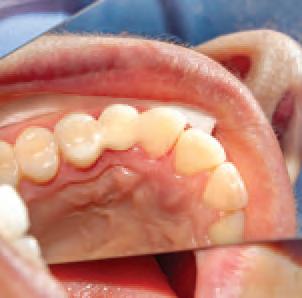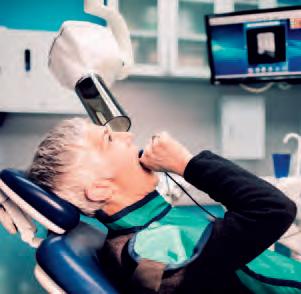
8 minute read
PRACTICE MANAGEMENT
Vulnerable areas:
an analysis of Dental Protection cases
Dental Protection’s recent ‘Learning from Cases’ report highlights the key areas that generated claims for compensation between January 2018 and December 2020.
This article explores a sample of the cases reviewed and identifies vulnerable areas in record keeping, consent, assessment and treatment planning, and radiographic practice, any of which can lead to difficulty defending a claim.
Record-keeping issues
Good clinical records are the dentist’s best defence. A lack of systematic, detailed notes leaves a dentist vulnerable to allegations that the approach to treatment was not properly structured, or adequately planned and executed. The difficulty for any clinician is the lack of evidence of the standard of their care. A failure to record investigations, findings, or giving advice and warnings to a patient, leaves the clinician exposed to accusations that these were not carried out appropriately. The matter will become a contest between the patient’s version of events and that of the dentist. Given that patients are in the surgery far less than any dentist, in a dispute a patient’s recollection of an event could be perceived to carry more weight than the dentist’s if there is no detailed documentation. It is also important to remember that a significant proportion of claims arise several years after treatment was provided, when recollection of events will inevitably be compromised. Commonly overlooked areas include: 4 presenting symptoms – nature, site, findings, diagnosis; 4 discussions and consent process – risks, benefits, alternatives, prognosis, costs, etc.; 4 structured treatment plans; 4 failure to record periodontal screening indices, e.g., basic periodontal
examination (BPE) scores; 4 failure to provide appropriate advice, e.g., oral hygiene/diet/smoking cessation; 4 specific measurements – working lengths, pocket depths, mobility; 4 radiographic details – rationale for exposure, report, findings; 4 antibiotic prescribing rationale; 4 informing patients of adverse events, e.g., file fracture, retained root; and, 4 post-op instructions or advice given.

Key learning points 4 Records commonly lack detail that can be important; 4 the reason why treatment was carried out, as well as what was done, should be recorded; and, 4 records need to be contemporaneous – non-contemporaneous additions need to be clearly identified as such.
Dr Martin Foster
BDS MPH DipHSM

Dr Noel Kavanagh
Noel is the Senior Dental Educator and Martin is Dentolegal Consultant at Dental Protection CASE 1 – alleged unnecessary treatment and failure to investigate pain
This patient presented with an unrestorable UL2, which was extracted by Dr B. Following this, further treatment was provided over the course of five appointments, during which a total of 13 existing amalgam restorations were removed and replaced with composite restorations. Shortly afterwards the patient returned complaining of pain in the lower jaw, which was initially managed with antibiotics and painkillers, before referral to a facial pain specialist to investigate possible trigeminal neuralgia. The patient later advised that they had attended elsewhere for root treatment at LR6, which had addressed their symptoms. A claim was raised alleging failure to adequately investigate and diagnose the source of pain, as well as providing unnecessary treatment. The records gave no indication of why the restorations had been replaced, why treatment was necessary, what advice had been provided, or if any consent process had been followed. No intra-oral radiographs were taken at any point
and the referral to the pain specialist was made without any evidence showing appropriate investigation of possible dental causes. Breach of duty was established based upon the lack of evidence that the treatment was indicated, or that the expected level of care had been taken when assessing the clinical presentation.
Key learning point 4 The rationale for treatment decisions must be clear from the information in the clinical records – it is important to show not just what was done but why.
CASE 2 – alleged cause of facial pain
In this case, the dentist provided fixed bridgework from UR3 to UR6 to restore the space created by the loss of UR4 and UR5. The patient later developed facial pain, which was allegedly caused by the member’s treatment. Cases involving ‘atypical’ or ‘neuropathic’ pain can create difficulties as, by the nature of this condition, it is not always possible to ascertain the precise mechanism at play. If there is any suggestion of fault with the dental treatment, this can lead to blame being attributed to the dental intervention. In this case, the dentist’s records were detailed, and it was clear that the approach to assessment, treatment planning and technical execution had been both appropriate and systematic. There was no fault with the treatment and the claimant was unable to provide any evidence linking the onset of symptoms and the treatment. The claim was dropped.
Key learning point 4 Claims can arise from issues that are not linked to the treatment provided –it is important to be able to produce evidence of the quality of treatment to prevent any suggestion of substandard work that may be implicated.

Consent issues
A lack of evidence of a consent process is a vulnerability in cases of all types. This exposes the dentist to allegations of a breach of duty, which are then difficult to defend against. Often, there are inadequate or no records of any discussions with the patient – even though the patient had been advised of options and warned of risks.
An allegation seen in many claim letters is: “Had our client been made aware of the limited prognosis for treatment at the start, then

they would not have proceeded with treatment”. Consent is an ongoing process and should be revisited if there are any proposed changes to the original treatment. For elective treatment particularly, detailed documentation of the consent process is of paramount importance. A consent form can be an adjunct to a record entry but does not remove the need for recording the process in the notes. Forms should not be relied upon alone. Any forms used need to be relevant to the specific risks for that individual patient. Without a documented consent process, including discussions with the patient regarding treatment options, alternatives, advantages and disadvantages, limitations, risks, prognosis of proposed treatment and costs, there will be little prospect of successfully contesting a claim.
Pre-op assessment/treatment planning issues

Another significant danger area arises in relation to case assessment. If the clinician’s grasp of the clinical situation is not accurate, this will undermine the prospect of a successful outcome, and create both clinical and dentolegal risk. Insufficient attention to pre-operative case assessment and treatment planning can lead to difficulties, which a more careful approach could have avoided. A robust pre-op assessment helps to ensure that there is a clearer understanding of the clinical picture, including possible complications, and will put the clinician in a position to more accurately judge if the treatment is within their competence and experience before proceeding. It is important that the patient’s expectations are realistic and aligned with the clinical findings and potential treatment outcomes. Sometimes it may be necessary to reconsider and revise treatment plans, e.g., in light of a tooth becoming non-vital, is it still suitable as a bridge abutment or does the plan need re-evaluation? Common failings seen in claims include: 4 failure to adequately assess and advise on the condition of teeth preoperatively; 4 inadequate investigations/special tests/diagnostics; 4 using and relying upon inappropriate radiographs for assessment; 4 failure to identify the most appropriate approach to address clinical presentation; 4 periodontal condition not recorded; 4 failure to stabilise dentition before proceeding with complex treatment; and, 4 failure to assess abutment teeth radiographically, periodontally, etc.

CASE 3 – case assessment and consent issues
Dr A. placed five implants in the upper arch to support fixed anterior bridgework. Two months later the two implants on the right side became loose. The bridgework and the two failed implants were removed. The patient shortly afterwards attended another practice for further treatment. The legal claim alleged that the patient had suffered pain and infection, along with psychological trauma. Compensation was sought in addition to the costs of remedial treatment. The allegations also included failure to obtain valid consent. Implants can fail for a variety of reasons, so this risk needs to be clearly conveyed. The vulnerabilities in the case included a lack of adequately documented consent. The clinical assessment was poorly recorded with no evidence of a structured approach. Breach of duty was established from being unable to demonstrate that appropriate care was taken in planning the treatment and advising the patient.

Key learning points 4 When providing complex restorations, records must demonstrate thorough assessment, treatment planning and consent; and, 4 accurate information is at the heart of consent – a failure to record that an adequate and appropriate assessment was undertaken will undermine any argument that consent was valid.
Radiographic issues
Radiographs and scans are an element of cases that can create problems either through not being taken when they should be, being taken badly, or not being examined or reported on. Common weaknesses with radiographs and scans include: 4 poor positioning or poor diagnostic value or quality; 4 findings not recorded/reported/acted upon; 4 no X-rays taken for RCTs; and, 4 inappropriate use of OPGs (magnification distortion). The findings on a radiograph or scan should be recorded, since this information is part of the clinical assessment. It is important to record the rationale for taking radiographs and report the findings. Make sure you use the appropriate radiograph for the clinical situation and use good technique (e.g., positioning) to maximise diagnostic yield. You should observe recognised guidelines for dental radiography, e.g., indications and/or frequency. By exploring the common pitfalls and themes that result in a claim, and the lessons that can be learned from them, dental professionals can feel empowered to take preventive and precautionary steps to reduce the likelihood of claims, and feel confident that when claims do arise, they can be defended successfully.
Dental Protection’s ‘Learning from Cases’ report is available from: https://www.dentalprotection.org/ireland/publicationsresources/articles/article/learning-from-cases—-the-claimslandscape-for-dentists-in-ireland.











